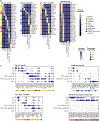How Many Cell Types Are in the Kidney and What Do They Do?
- PMID: 34843404
- PMCID: PMC9233501
- DOI: 10.1146/annurev-physiol-052521-121841
How Many Cell Types Are in the Kidney and What Do They Do?
Abstract
The kidney maintains electrolyte, water, and acid-base balance, eliminates foreign and waste compounds, regulates blood pressure, and secretes hormones. There are at least 16 different highly specialized epithelial cell types in the mammalian kidney. The number of specialized endothelial cells, immune cells, and interstitial cell types might even be larger. The concerted interplay between different cell types is critical for kidney function. Traditionally, cells were defined by their function or microscopical morphological appearance. With the advent of new single-cell modalities such as transcriptomics, epigenetics, metabolomics, and proteomics we are entering into a new era of cell type definition. This new technological revolution provides new opportunities to classify cells in the kidney and understand their functions.
Keywords: cell plasticity; kidney cell types; kidney function; single-cell RNA sequencing.
Figures




References
-
- Bernard C 1878. Leçons sur les pheńomeǹes de la vie communs aux animaux et aux veǵet́aux. Paris: J.B. Baillier̀e
-
- Smith HW. 1953. From Fish to Philosopher. Boston: Little, Brown
-
- Smith HW. 1956. Principles of Renal Physiology. New York: Oxford Univ. Press
Publication types
MeSH terms
Grants and funding
LinkOut - more resources
Full Text Sources
Other Literature Sources

